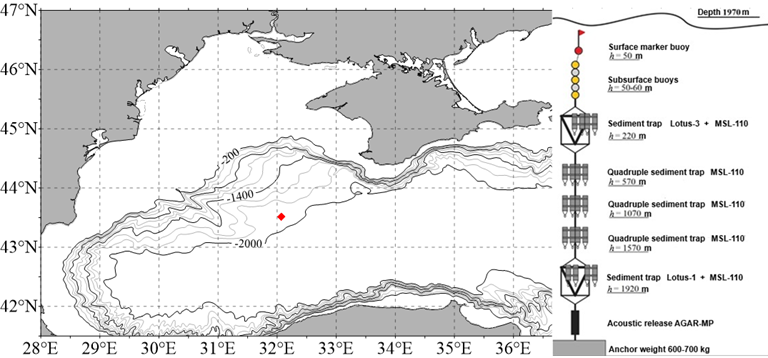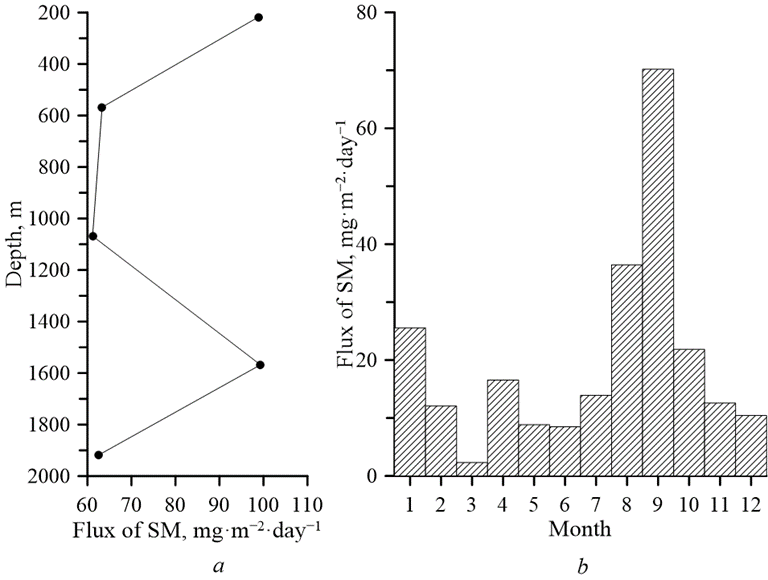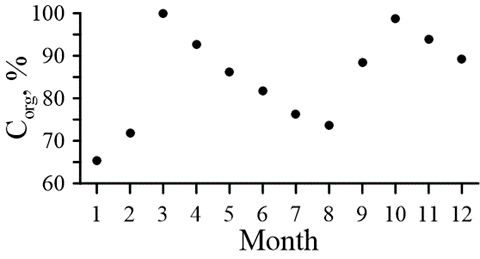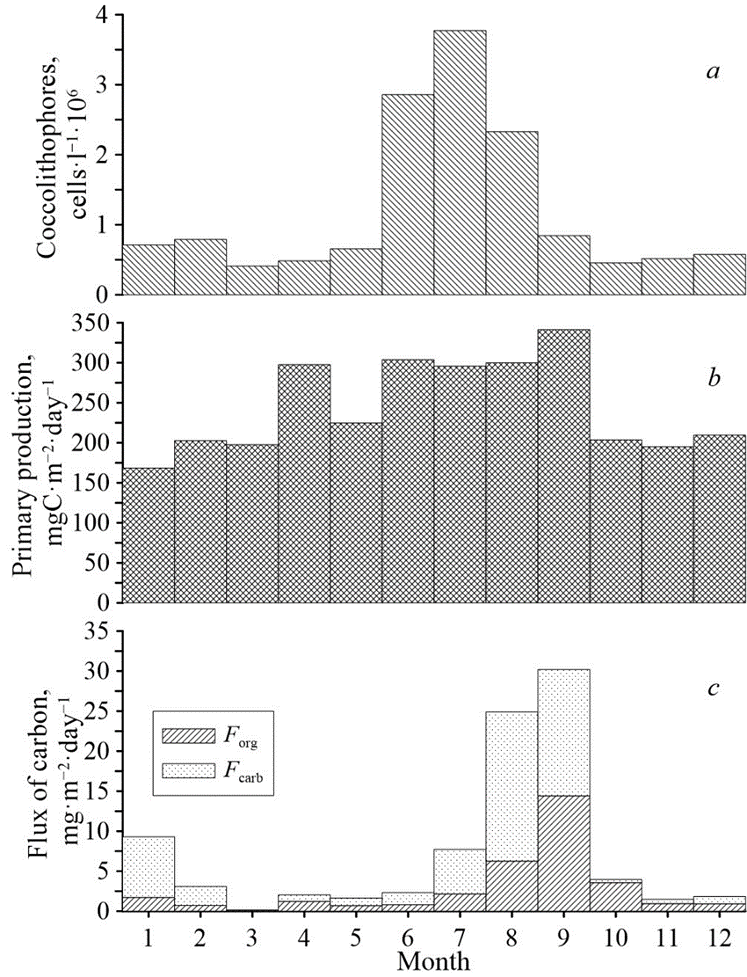Россия
Россия
Purpose. The purpose of the work is to analyze the suspended matter (SM) flux in the deep part of the Black Sea, assess its variability and investigate the transformation of its composition under anaerobic conditions based on the data collected in 2021–2022. Methods and Results. The data were obtained by means of sediment traps installed at five horizons along the transect between Cape Chersonesus and Bosphorus Strait in the Black Sea. The automatic deep-sea sedimentation observatory (AGOS) was installed during the 119th cruise of the R/V Professor Vodyanitsky and retrieved during the 124th cruise in 2022. The research covered all the seasons in 2021–2022. To collect the material, two types of traps were incorporated into AGOS: to determine the SM vertical distribution and to study its seasonal variation. The processing of the data was conducted using a uniform methodology, which included filtration, drying, gravimetric analysis for the calculation of suspended particulate matter fluxes, as well as determination of the organic and inorganic carbon contents by the coulometric titration method in the laboratory of Marine Hydrophysical Institute of RAS. The study yielded data on the vertical distribution of SM flux and its seasonal variation. The distribution patterns of SM, as well as the organic and inorganic carbon involved in its composition, were revealed. Conclusions. The dynamics of SM and carbon fluxes are determined by different physical and biogeochemical processes. The SM fluxes are distributed unevenly across depth and change seasonally throughout the year. An analysis of the integral trap data shows that the SM fluxes exhibit variability across different depths, with a range of 62–99 mg·m‒2·day‒1. At depths of 218 and 1568 m, the intensity is at its maximum. Its decrease depends on various biogeochemical processes, including dissolution, oxidation and mineralization. The increase in SM fluxes can be attributed to both deep-sea currents and physical and chemical sorption processes. The seasonal changes in SM flow are represented by two peaks: the maximum occurs during the period July – September, while the minimum occurs in March. Carbon concentration in SM exhibits fluctuations with depth and across seasonal cycles, which are mainly shaped by biological processes. The discrepancy between the peaks of the coccolithophore bloom at the surface and the maximum values of the inorganic carbon flux recorded by the trap can be explained by the sedimentation rates.
suspended matter, organic carbon, inorganic carbon, carbonates, sediment traps, coccolithophores, Black Sea
Introduction
Suspended matter (SM) is an important component of the marine ecosystem. Its composition is mainly formed in the upper water column as a result of the complex interaction of substances from various geospheres, including the lithosphere, atmosphere, hydrosphere, and biosphere [1]. The suspended matter can be divided into two main categories: lithogenic and biogenic. The lithogenic components are of terrigenous and abiogenic origin and enter the system through various means, including river runoff, mechanical destruction of riverbanks, aeolian transport, and melting ice. The biogenic components are the remains of once-living and dead organisms, formed from organic matter (Corg), amorphous silica (SiO2bio), and suspended calcium carbonate (CaCO3), which are part of plankton and its detritus [2–4].
A change in oxidation-reduction conditions typically results in the change of ratio and content of lithogenic and biogenic SM components. The qualitative and quantitative SM composition in a water column reflects the transformation processes occurring therein. Given that carbon is a key component of SM, the study of its organic and inorganic forms, as well as their ratio, enables the investigation of the predominant mechanisms governing the carbon cycle in the hydrosphere. The content of organic carbon (Corg) in SM reflects the ecosystem productivity, intensity of biochemical processes in it and resistance to the effects of various natural and anthropogenic factors [5, 6]. Carbonates also play a substantial role in the SM, comprising both terrigenous carbonates transported from land and autochthonous carbonates formed in the water column [7]. Inorganic carbon (Ccarb) is a structural component of carbonate minerals, which are represented in suspension by biogenic and chemogenic formations.
According to long-term studies of phytoplankton, the main carbonate-concentrating biogenic particles in the SM composition in the Black Sea are Emiliania huxleyi, species of coccolithophore [8, 9]. These algae act as an intermediary in the transfer of Сcarb from the atmosphere and the euphotic zone to bottom sediments. This is due to the fact that at the conclusion of the "bloom", coccolithophores partially settle to the bottom, where they constitute the main component of calcareous silts [8].
In the water column, finely dispersed SM micro- and nanoparticles aggregate under the influence of biological (water filtration by zooplankton organisms with the transformation of sedimentary matter into pellets and amorphous lumps (marine snow)), as well as physicochemical (coagulation, flocculation of colloids) processes. As a result, vertical fluxes of sedimentary matter are formed. They are transformed when passing through the water column and are ultimately subject to the burial process in the form of bottom sediments [7]. Accordingly, the study of the vertical distribution of SM is the basis for understanding the modern sedimentation processes [1].
In this way, the study of SM flux and its formation and transformation mechanisms is a pressing oceanographic task.
Until recently, studies of SM in the Russian sector of the Black Sea were episodic in nature [6, 10] and were carried out primarily in shelf areas [11]. The most comprehensive review of SM study and its flux in the Black Sea is presented in [1]. Modern studies of SM are based primarily on satellite data [3–5, 12], but this approach has a number of shortcomings, in particular the inability to study the vertical SM profile and its transformation processes.
In 2015, the researchers of the Institute of Oceanology of RAS began studying the vertical profile and intra-annual variability of SM in the open part of the Black Sea [1]. In the deep part, sediment traps were installed as part of the automatic deep-sea sedimentation observatory (AGOS), the concept of which was developed by the Academician A.P. Lisitsyn and put into practice in sedimentological research [13, 14].
The AGOS concept implies the possibility of using an integrated approach to the study of SM fluxes in order to determine the associated parameters, namely: determination of the main parameters of the upper water layer by remote sensing methods using satellite imagery; use of sediment traps with different time resolutions installed at different depths; connection of additional probes to determine the hydrological parameters of the environment at the trap site (currents, temperature, salinity, content, transparency, fluorescence, etc.).
The purpose of the work is to quantify the suspended matter (SM) flux in the deep part of the Black Sea, its variability and compositional change under anaerobic conditions based on the data of 2021–2022.
Materials and methods
The data were obtained through the installation of sediment traps at five horizons in the deep part of the Black Sea (station installation depth 1968 m) along the transect of Cape Chersonesus – Bosphorus Strait (distance from Cape Chersonesus is 180 km).
Two types of sediment traps were used for sampling: the first is capable of obtaining continuous material collection with a specified exposure time (Lotus-3 differential 12-cup sediment traps), while the second is an integral small cylindrical sediment trap, MSL-110, which collects material throughout the station’s operational duration [1]. Fig. 1 shows the location of the sediment traps. The AGOS observatory was installed during the 119th cruise of the R/V Professor Vodyanitsky on 24 September 2021. The station was retrieved on 4 October 2022, during the vessel’s 124th cruise. For integral collection of material over the course of the year, MSLs were installed at depths of 218, 568, 1068, 1568 and 1918 m. At depths of 218 m (Lotus-3) and 1918 m (the Lotus-1 trap was not operational, the data are not discussed in the paper), differential sediment traps with an exposure time of 30 days were installed. Thus, the period of AGOS operation at different depths and with a given discreteness of SM collection was 12 months (375 days), it covered all seasons from September 2021 to October 2022. To preserve the collected material in conditions as close to natural as possible, the receiving containers were filled with a 4% sodium chloride solution, which is twice the average salinity of the Black Sea waters.
At a depth of 218 m, the traps were installed to estimate the flux from the upper quasi-homogeneous layer, at a depth of 1918 m – to estimate the flux reaching the bottom and participating in the formation of sediments. Three intermediate depths were selected to estimate the SM flux variability with depth.
Following retrieval, the containers containing the SM samples were stored in a refrigerated chamber until laboratory processing, which was carried out using a single method described in [1].
The samples were vacuum filtered through parallel pre-weighed nuclear filters with a 0.45 μm pore size to determine the total SM flux, as well as through Whatman GF/F glass fiber filters calcined at 450°C to determine the total, organic and carbonate carbon content.
After drying at 60°C until a constant mass was achieved, the filters were weighed with the filtered substance present. This enabled the total amount of material to be obtained (dry SM mass, mg). The material was weighed using the Adventurer AR2140 analytical laboratory scale with a measurement accuracy of up to 0.0001 g.
The SM flux was calculated as the ratio of the dry SM mass to the product of the trap collection area and the exposure time:
 , (1)
, (1)
where F is the SM flux, mg∙m‒2∙day‒1; m is the dry SM mass, mg; S is the collection area, m2; T is the exposure time, day.
The total, organic and carbonate carbon contents were determined by coulometric titration on an AN-7529 carbon analyzer [15].

F i g. 1. Scheme of the AGOS (a) and the area of its installation (b)
Results and discussion
The vertical flux of SM, the Corg and Ccarb content in samples were determined using the data obtained from sediment traps, and the fluxes of organic and inorganic carbon with SM were calculated. The seasonal variability of the SM fluxes was studied at a depth of 218 m. The fluxes were characterized by distribution heterogeneity with regard to depth and temporal variation (Fig. 2).

F i g. 2. Vertical (a) and seasonal (b) variability of the SM flux based on the 2021–2022 data
The data obtained from the integral traps indicates that the SM flux exhibited a range of 62–99 mg·m‒2·day‒1 (Fig. 2, a). Two peaks of the same intensity (99 mg·m‒2·day‒1) were noted at depths of 218 and 1568 m. At depths of 568, 1068 and 1918 m, the value decreased and was 61–63 mg·m‒2·day‒1. The order of these values is comparable with both modern data for 2015–2016 for the central part of the sea at the foot of the northwestern slope of the deep-sea basin [1], and with the data from the 1980s for the Anatolian coast [16–18].
The seasonal variability of the SM flux at a depth of 218 m was characterized by a maximum in September (70.2 mg·m‒2·day‒1 over a 30-day period) and a minimum in March (2 mg·m‒2·day‒1) (Fig. 2, b). In general, the SM flux values exhibited a range of 9–36 mg·m‒2·day‒1, which corresponds to the data presented in [1, 16–18].
The distribution of carbon, a principal SM component, correlated with the vertical profile of its flux. Maximum concentrations were observed at depths of 218 and 1568 m (19.25 and 19.52%, respectively), while at depths of 568, 1068 and 1918 m, concentrations remained within narrow limits of 17.29–17.68%. The ratio of organic and inorganic forms of carbon changed slightly with depth (Fig. 3, b), with the contribution of organic carbon averaging 83%.

F i g. 3. Distribution of organic (Corg) and inorganic (Ccarb) forms of carbon with depth (a) and during a year (b)
During the year, the carbon content in SM exhibited a range of 5–23.29%, with a maximum observed in August and September and a minimum in March, when the minimum SM flux was also recorded (Fig. 2, b). The seasonal variability of the Corg concentration qualitatively coincided with that of the SM flux, with minima observed in March and November (5.0 and 7.54%, respectively) and maxima in July – September (16.3–20.53%) (Fig. 3, b). The distribution of Ccarb in SM was somewhat different: concentration minima were observed in the spring and autumn periods (in March, April and October, November, respectively).
A comparable distribution of organic and inorganic forms of carbon revealed that the organic component is also characterized by pronounced seasonality, with maxima in March and October (Fig. 4). During the first period, a gradual decline in the Corg share was observed, reaching a reduction of 25% from March to August. In contrast, during the second period, a sharper decline in the Corg share was noted from October to January.

F i g. 4. Share of organic component in total carbon in SM
Discussion of the results
Vertical profile. The variation in SM flux intensity with depth is the result of the influence of physical and biogeochemical processes. The data obtained using sediment traps enabled the determination of vertical fluxes with regard to the Corg and Ccarb content in samples, as well as the calculation of organic and inorganic carbon fluxes with SM. The seasonal variability of these fluxes was studied at a depth of 218 m.
The Ccarb flux for the Black Sea is primarily influenced by processes involving coccolithophores, given their prevalence as the dominant algae with a carbonate skeleton within this ecosystem [8, 9]. Due to insufficient saturation of deep-water masses with carbonates [19], as well as a pH decrease and an increase in the CO2 concentration, carbonates should dissolve, which is manifested in a decrease in the Ccarb flux with depth (Fig. 3, a):
CaCO3 + CO2 + H2O ↔ Ca2+ + 2 HCO3‒. (2)
The SM flux increase at a depth of 1568 m and below is possibly due to the influence of deep currents [10]. According to [20], the advective transport of water occurs in the lower nepheloid layers, which are formed as a result of bottom erosion under the action of internal tides and waves. Fine-grained, resuspended sediments, including clay particles, silt and coccolith, are often involved in this form of bottom horizontal transport [16, 17].
The SM concentration increase can also be determined by the influence of anaerobic conditions of the Black Sea waters and a number of features of the biochemical reactions under these conditions. Thus, some researchers associate this with reactions involving manganese, iron and other trace elements that form insoluble sulfides in the hydrogen sulfide zone, which subsequently precipitate, sorbing some of the dissolved compounds, and contribute to the formation of a complex suspension [10]. The presence of pyrites in the suspension of the deep Black Sea is shown in [1]. In addition, the carbon flux share is 20% of the SM flux, which indicates a complex component composition of the SM and confirms the theory of the formation of metal sulfides in the anaerobic layer, in particular iron and manganese, and their sorption of other dissolved components with the formation of complex compounds:
Me2+ + S2‒ → MeS↓. (3)
The results of our studies indicate a reduction in the SM flux with depth, and a qualitative alignment between the organic matter flux profile and the vertical SM flux profile (Fig. 2, a; 3, a). Consequently, it can be assumed that in the deep Black Sea, the organic component plays a dominant role in the SM formation. Additionally, the data [1] indicate that as depth increases, the concentration of carbonates decreases significantly and is not determined at a depth of 1775 m. At the same time, the observed increase in the SM flux intensity at a depth of 1568 m and the Corg concentration is likely attributed to physical transfer processes.
Seasonal variability of SM flux and carbon. Installation of long-term sediment traps with a specified exposure time, followed by collection and analysis of material, enables the investigation of the role of various physical, chemical and biological processes in the formation and transformation of SM under changing conditions.
The seasonal variability of SM characteristics and its flux is primarily determined by biological processes involving plankton and bacteria, which, in turn, are also dependent on hydrological conditions and seasonal phenomena [10], including seasonal cycles of primary producers, the “bloom” of coccolithophores and diatom microalgae, in the euphotic zone of the deep Black Sea [18, 21, 22].
The peaks in the SM flux values at a depth of 218 m occur during the summer (August) and autumn (September) periods (36.4 and 70.2 mg·m‒2·day‒1, respectively). Their total contribution represents 45% of the total annual flux value (Fig. 2).
In consideration of the satellite data (Fig. 5, a), which indicates that the coccolithophore “bloom” occurred in June [9], and the trap data, which shows the maximum contribution of carbonates to the SM flux occurred in July, August and September (40.1, 51.1 and 22.5%, respectively (Fig. 5, c)), it can be assumed that the SM flux is derived from the carbonate component and the sedimentation of coccolithophores during this period. The SM sedimentation rate in this case should be approximately 7–9 m·day‒1, which is consistent with the data presented by [23].
The observed lag of one to two months between the peak of phytoplankton productivity in the euphotic zone and the maximum values of inorganic carbon flux (represented mainly by coccolithophores) can also be attributed to sedimentation rates (within the 1–36 m·day‒1range) [24].

F i g. 5. Concentrations of coccolithophores (a) and primary production (b) in the area of the installed trap, based on satellite data for 2022; seasonal variations of organic carbon flux (Forg) and inorganic carbon, as component of carbonates flux (Fcarb), in SM at a depth of 218 m, based on the Lotus trap data (c)
The remainder of the time, the SM flux varied within the range of 2.3–25.5 mg·m‒2·day‒1 with an average value of 13 mg·m‒2·day‒1. It was characterized by alternating maxima and minima (Fig. 2). The minimum SM flux occured in March; during this period, it was determined only by the organic component with no inorganic component present (Fig. 3, b; 4, 5). The Black Sea waters are characterized by two peaks of phytoplankton “bloom” – autumn-winter (more intense, the maximum occurs in November – December) and winter-spring [25], this is also reflected in the seasonal distribution of SM and its flux (Fig. 2, b).
Thus, the seasonal dynamics of the SM flux mainly coincides with the dynamics of primary production and the number of coccolithophores (Fig. 5) [9, 26].
Conclusion
The seasonal dynamics of the SM and carbon flux are determined by the influence of both physical and biogeochemical processes. The distribution of SM fluxes was found to exhibit heterogeneity with depth and over the course of the year.
The presence of two SM flux peaks of the same intensity at depths of 218 and 1568 m was observed. The reduction in the SM flux intensity is due to the occurrence of biogeochemical processes leading to the dissolution, oxidation and mineralization of substances that constitute SM. The increase in the concentration of SM and its flux is the result of the influence of currents or the occurrence of physicochemical processes of sorption on metal sulfides.
The seasonal variability of the SM flux was primarily determined by biological processes involving plankton, with the organic component contributing 83%. The peaks in the SM flux values occurred in the summer period, with their total contribution representing 45% of the annual flux values.
The lowest SM flux was recorded in March, during this period it was determined only by the organic component with no contribution from the inorganic component.
The seasonal dynamics of SM flux correspond to satellite data on primary production and coccolithophore abundance. Furthermore, the ratio of the peak times of their “bloom” in the photosynthesis zone and inorganic carbon fluxes at a depth of 218 m correlates with the calculated sedimentation rates, which range from 1 to 36 m·day‒1.
The measurements were conducted at the Center for Collective Use of the R/V Professor Vodyanitsky of A.O. Kovalevsky Institute of Biology of the Southern Seas of RAS.
1. Klyuvitkin, A.A., Kravchishina, M.D., Lisitsyn, A.P., Demina, L.L., Dara, O.M., Novigatsky, A.N., Rusanov, I.I. and Solomatina, A.S., 2018. Vertical Fluxes of Dispersed Sedimentary Matter in the Deep-Water Part of the Black Sea. In: A. P. Lisitsyn, ed., 2018. The Black Sea System. Moscow: Scientific World, pp. 350-397. https://doi.org/10.29006/978-5-91522-473-4.2018 (in Russian).
2. Lisitsyn, A.P., 1977. [Terrigenous Sedimentation, Climatic Zonation and Interaction of Terrigenous and Biogenic Material in the Oceans]. Litologiya i Poleznye Iskopaemye, (6), pp. 3-22 (in Russian).
3. Kukushkin, A.S. and Parkhomenko, A.V., 2021. Spatiotemporal Variability of Suspended Particulate Matter in the Surface Layer of the Open Part of the Black Sea. Oceanology, 61(2), pp. 272-282. https://doi.org/10.1134/S0001437021010124
4. Kukushkin, A.S. and Suslin, V.V., 2020. Assessment of Applicability of Satellite-Derived Ocean Color Data for Studying Variability of Total Suspended Matter in the Surface Layer of the Deep Part of the Black Sea. Physical Oceanography, 27(5), pp. 547-556. https://doi.org/10.22449/1573-160X-2020-5-547-556
5. Kukushkin, A.S. and Parkhomenko, A.V., 2019. Variability of the Content of Suspended Organic Matter along the Southwestern Crimean Coast According to Ship and Satellite Observations. Sovremennye Problemy Distantsionnogo Zondirovaniya Zemlii iz Kosmosa, 16(1) pp. 137-146. https://doi.org/10.21046/2070-7401-2019-16-1-137-146 (in Russian).
6. Burlakova, Z.P., Eremeeva, L.V. and Konovalov, S.K., 2000. Seasonal and Spatial Variability of the Content of Suspended Organic Substances in the Active Layer of the Black Sea. Physical Oceanography, 10(5), pp. 419-454. https://doi.org/10.1007/BF02515365
7. Lukashin, V.N. and Lisitzin, A.P., 2016. Geochemistry of Dispersed Sedimentary Matter and Its Fluxes in the Water Column of the Caspian Sea. Oceanology, 56(5), pp. 675-689. https://doi.org/10.1134/S000143701605009X
8. Shoman, N.Yu., Solomonova, E.S. and Akimov, A.I., 2022. Influence of Light on Change in Morphophysiological Characteristics of Coccolithophorids Emiliania Huxleyi. Russian Journal of Plant Physiology, 69(2), 40. https://doi.org/10.1134/S1021443722020170
9. Mikaelyan, A.S., Silkin, V.A. and Pautova, L.A., 2011. Coccolithophorids in the Black Sea: Their Interannual and Long-Term Changes. Oceanology, 51(1), pp. 39-48. https://doi.org/10.1134/S0001437011010127
10. Vityuk, D.M., 1975. Suspended Matter and Its Components in the Black Sea. Hydrobiological Journal, 11(1), pp. 12-18 (in Russian).
11. Denisov, V.I. and Latun, V.V., 2018. Flows of Chemical Elements in Suspended Matter Fluxes in the Shallow Area of the Black Sea Shelf (According to the Sediment Traps Data). Izvestiya Vuzov. Severo-Kavkazskii Region. Natural Science, (4), pp. 77-85. https://doi.org/10.23683/0321-3005-2018-4-77-85 (in Russian).
12. Kukushkin, A.S., 2020. Estimation of the Variability of Suspended Matter Content in the Deep-Water Part of the Black Sea Using Satellite Data. Sovremennye Problemy Distantsionnogo Zondirovaniya Zemli iz Kosmosa, 17(2), pp. 184-191. https://doi.org/10.21046/2070-7401-2020-17-2-184-191 (in Russian).
13. Lisitsyn, A.P., Lukashin, V.N., Novigatskii, A.N., Ambrosimov, A.K., Klyuvitkin, A.A. and Filippov, A.S., 2014. Deep-Water Observatories in the Trans-Caspian Cross Section: Continuous Studies of Scattered Sedimentary Matter. Doklady Earth Sciences, 456(2), pp. 709-713. https://doi.org/10.1134/S1028334X14060166
14. Lisitsyn, A.P., Novigatskii, A.N., Shevchenko, V.P., Klyuvitkin, A.A., Kravchishina, M.D., Filippov, A.S. and Politova, N.V., 2014. Dispersed Organic Matter and Its Fluxes in Oceans and Seas from the Example of the White Sea: Results of a 12-Year Study. Doklady Earth Sciences, 456(1), pp. 635-639. https://doi.org/10.1134/S1028334X14050353
15. Zabegaev, I.A., Shul’gin, V.F. and Orekhova, N.A., 2021. Application of Instrumental Methods for Analysis of Bottom Sediments for Ecological Monitoring of Marine Ecosystems. Scientific Notes of V.I. Vernadsky Crimean Federal University. Biology. Chemistry, 7(4), pp. 242-254 (in Russian).
16. Honjo, S., Hay, B.J., Manganini, S.J., Asper, V.L., Degens, E.T., Kempe, S., Ittekkot, V., Izdar, E., Konuk, Y.T. [et al.], 1987. Seasonal Cyclicity of Lithogenic Particle Fluxes at a Southern Black Sea Sediment Trap Station. In: E. T. Degens, E. Izdar and S. Honjo, eds., 1987. Mitteilungen des Geologisch-Paläontologischen Instituts der Universität Hamburg: SCOPE/UNEP Sonderband, 62, pp. 19-39.
17. Izdar, E., Konuk, T., Ittekkot, V., Kempe, S. and Degens, E.T., 1987. Particle Flux in the Black Sea: Nature of the Organic Matter. In: E. T. Degens, E. Izdar and S. Honjo, eds., 1987. Mitteilungen des Geologisch-Paläontologischen Instituts der Universität Hamburg: SCOPE/UNEP Sonderband, 62, pp.1-18.
18. Izdar, E., Konuk, T., Honjo, S., Asper, V., Manganini, S., Degens, E.T., Ittekkot, V. and Kempe, S., 1984. First Data on Sediment Trap Experiment in Black Sea Deep Water. Naturwissenschaften, 71, pp. 478-479. https://doi.org/10.1007/BF00455904
19. Zeebe, R.E. and Wolf-Gladrow, D., 2001. CO2 in Seawater: Equilibrium, Kinetics, Isotopes. Amsterdam: Elsevier, 360 p.
20. Dickson, R.R. and McCave, I.N., 1986. Nepheloid Layers on the Continental Slope West of Porcupine Bank. Deep Sea Research Part A. Oceanographic Research Papers, 33(6), pp. 791-818. https://doi.org/10.1016/0198-0149(86)90089-0
21. Samyshev, E.Z. and Minkina, N.I., 2017. The Seasonal Variability and Sedimentation Rate of Suspended Matter in Photic Layer of the Black Sea. Environment and Ecology Research, 5(3), pp. 227-234. https://doi.org/10.13189/eer.2017.050308
22. Smetacek, V., von Bröckel, K., Zeitzschel, B. and Zenk, W., 1978. Sedimentation of Particulate Matter during a Phytoplankton Spring Bloom in Relation to the Hydrographical Regime. Marine Biology, 47, pp. 211-226. https://doi.org/10.1007/BF00541000
23. Parkhomenko, A.V. and Kukushkin, A.S., 2018. Sediment Flux of Particulate Organic Phosphorus in the Open Black Sea. Oceanology, 58, pp. 240-249. https://doi.org/10.1134/S0001437018020145
24. Asper, V.L., 1987. Measuring the Flux and Sinking Speed of Marine Snow Aggregates. Deep Sea Research Part A. Oceanographic Research Papers, 34(1), pp. 1-17. https://doi.org/10.1016/0198-0149(87)90117-8
25. Vostokov, S.V., Lobkovskiy, L.I., Vostokova, A.S. and Solov’ev, D.M., 2019. Seasonal and Interannual Variability of Phytoplankton in the Black Sea on the Basis of Remote Sensing Data and In Situ Measurements of Chlorophyll-a. Doklady Earth Sciences, 485(1), pp. 293-297. https://doi.org/10.1134/S1028334X19030097
26. Vostokov, S.V., Vostokova, A.S. and Vazyulya, S.V., 2022. Seasonal and Long-Term Variability of Coccolithophores in the Black Sea According to Remote Sensing Data and the Results of Field Investigations. Journal of Marine Science and Engineering, 10(1), 97. https://doi.org/10.3390/jmse10010097














